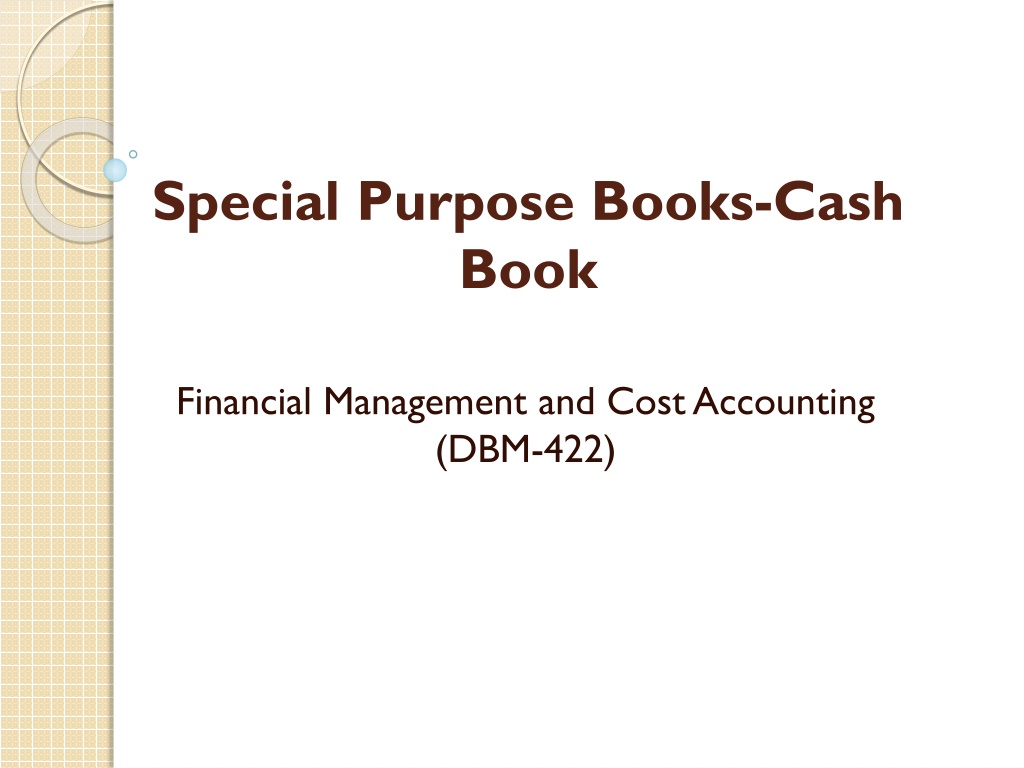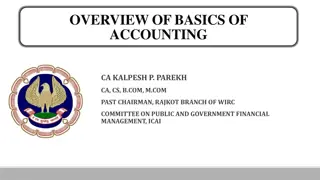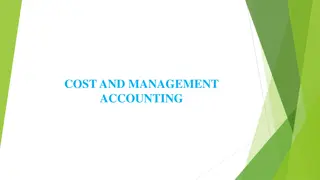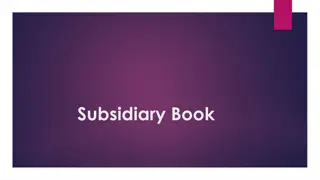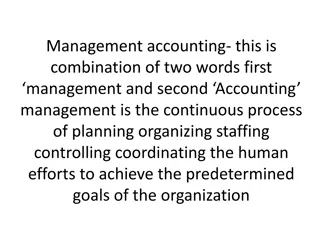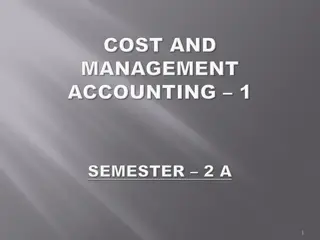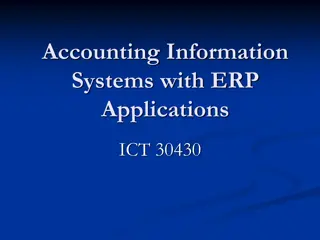Introduction to Subsidiary Books in Accounting
Business transactions are initially recorded in a Journal and then transferred to a Ledger for better organization. Subsidiary Books, such as Cash Book, Purchase Book, and Sales Book, help in recording specific types of transactions efficiently. These specialized books assist in preparing Ledger accounts and drawing up Trial Balances, making the accounting process more systematic and manageable.
Download Presentation

Please find below an Image/Link to download the presentation.
The content on the website is provided AS IS for your information and personal use only. It may not be sold, licensed, or shared on other websites without obtaining consent from the author. Download presentation by click this link. If you encounter any issues during the download, it is possible that the publisher has removed the file from their server.
E N D
Presentation Transcript
Special Purpose Books-Cash Book Financial Management and Cost Accounting (DBM-422)
Introduction Business transactions are first recorded in Journal and then posted into a Ledger. In practice, number of business transactions are too large It, thus, becomes difficult to record all of them in one book of primary entry. For example, most of the transactions may relate to receipt & payment o cash,sale of goods,purchase of goods. A register of this type is called a book of original entry or of primary entry. It is special form of a Journal. The system by which transactions of a class are first recorded in a book, specially meant for it, and then posted into a Ledger is called the Practical System of Accounting.
Subsidiary Books of Accounts These books of primary entry are also known as a Special Journal or Subsidiary Books because Ledger Accounts are prepared on their basis and without this process of Ledger posting, a Trial Balance cannot be drawn. The Ledger is thus called the Principal Book ofAccounts.
Types of Subsidiary Books Recording all transactions in a single book of primary entry is practically difficult. To make it convenient, the Journal is divided into a different Subsidiary Books,which are: 1. Cash book To record cash receipts and Payments, including banking transactions 2. Purchase Book: To record credit purchases of goods or the materials and stores required in the processing plants 3. Sales Book: To record the credit sales of goods by the firm 4. Purchase Returns Book: To record return of goods purchased on credit.
Types of Subsidiary Books Contd. 1. Sales Return Book: To record credit sales made by customers 2. Bills Receivable Book: To record the receipts of promissory notes from various parties 3. Bills Payable: To record the issue of promissory notes to other parties 4. Journal Proper: To record the transactions which cannot b recorded in an of the books mentioned above.
Cash Book Cash Book is a book of primary entry in which cash and bank transactions of business are recorded chronologically. It is imperative to regularly know the cash or bank balance. Cash receipt are recorded on the debit side of the cash book and Cash payments on the credit side. A balance is worked out by deducting the total cash payments from the total cash receipts.
Features of Cash Book Only cash transactions are recorded. Cash and cheque receipts are placed in the debit side. All cash and cheque payments are recorded in the credit side. It enters only one form of transaction, i.e. Cash Cash and bank transactions are recorded in chronologically in the cash book. It performs the function of both Journal and Ledger at the same time.
Cash Book Cash transactions are recorded in the Cash Book Ledger Accounts are prepared on the basis of records in cash Book. The Cash Book is, therefore, a subsidiary book. However, the Cash Book itself serves as the cash account and the bank account. The balances are entered in the Trial Balance directly. Cash Book is also treated as a Principal Book. The Cash Book, therefore, both a subsidiary Book and a Principal Book.
Types of Cash Book There are three types of Cash Books: 1. Simple Cash Book or single Column Cash Book Only cash transactions are recorded. 2. Two Column Cash Book It has Cash Book with cash and bank column for recording cash and bank transactions. 3. Three Column Cash Book Cash Book having cash,bank and discount column For recording cash and bank transactions involving loss or gain on account of discount.
Simple Cash Book Simple Cash Book looks like an account with one account column on each side. Receipts Payments Dr . Cr. Date Particulars V. No. L.F. Rs. Date Particulars V. No. L.F. Rs. Receipts Payments Left hand side records receipts of cash and right hand side records cash payments
Example: Enter the following transactions in a Simple Cash Book 2019 Jan. 11 Jan. 15 Jan. 17 Jan. 18 Jan. 20 Jan 24 Jan. 29 Rs. 1,20,000 30,000 3,000 30,000 70,000 20,000 10,000 Cash in Hand Received from Raj Paid rent Sold goods Paid Mohan Purchased furniture Paid salaries
Solution : Simple Cash Book In the Books of Raj Dr . Cr. Receipts Payments Date Particulars L.F. Rs. Date Particulars L.F. Rs. 2019 Jan. 11 Jan.15 {{{{{{{{{ 2019 Jan.17 Jan.20 Jan. 24 Jan. 29 Jan. 31 To Balance b/d To Raj To sales A/c 1,20,000 30,000 30,000 By Rent A/c By Mohan By Furniture A/c By Salaries A/c By Balance c/d 3,000 70,000 20,000 10,000 70,700 1,80,000 1,80,000 Feb. 1 70,700 It can be concluded that 1. Only cash receipts and cash payments are recorded in a Simple Cash Book. Credit transactions are not recorded. 2. Debit side is always larger than credit side since the payment can never exceed the available cash. 3. It is like an ordinary account.
